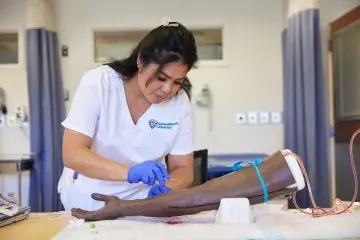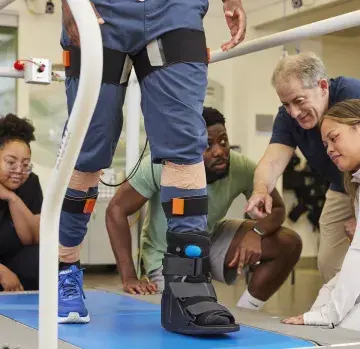New Motion Equipment Offers Teaching & Research
The Motion Analysis Research Center (MARC) is realizing its ambition as one of the best biomechanical laboratories for teaching and research in Northern California with new state-of-the-art tools to measure muscle strength and power.
“The MARC is entering a phase of its development where we now have the human and physical resources to fulfill virtually all of the goals set out for the center,” says MARC Director Drew Smith, PhD. “It is wonderfully satisfying to me to see how far we have come in such a short period of time.”
Opened in 2013, the 2,100-foot laboratory is designed to advance the study of human movement in education, research, and patient care. The MARC serves as a teaching center on motion analysis for faculty and students from SMU’s California School of Podiatric Medicine (CSPM), Doctor of Occupational Therapy program, and Doctor of Physical Therapy program.
Recent equipment purchases include a Biodex isokinetic dynamometer, a sophisticated system that tests muscle strength and power under a wide range of dynamic motion conditions.
The MARC also added two AMTI force platforms, which bring the total number of the center’s floor-mounted devices to its capacity of six. Smith says the new platforms provide the MARC with an array of force sensing that offers the flexibility to study balance, walking, and other human movements, such as tai chi and dancing.
A new treadmill instrumented with two force platforms, also from AMTI, enables researchers and clinicians to quickly record multiple strides in walking and running in a single trial.
“This equipment will not only make our regular gait analyses more efficient, but will allow us to study other phenomena such as how fatigue is exhibited in both healthy individuals across the age spectrum and those with neuromuscular conditions,” says Smith.
Boosting the MARC’s movement analysis capabilities is enabling the center to expand its educational and clinical opportunities.
Smith says more SMU faculty are using the MARC for teaching and research, and the new cutting-edge technology is helping students to more fully understand the dynamics of muscle strength and power, especially during walking and running tasks.
Healthcare practitioners across several fields use the center to study biomechanics, gait, upper and lower body movement — as well as the effect of treatment modalities — so they can apply what they learn in clinical practice for the benefit of patients.
“Outside partners, who now are aware of what a tremendous resource exists in the MARC, are approaching us to collaborate with them,” Smith says.
The center is planning to host clinical trials of new products and interventions designed to treat movement disorders, according to Smith. The new equipment will be used in several studies, including an examination of the relatively new “maximalist” running shoe design and a study on runners with iliotibial band syndrome, as well as a collaborative project with UCSF Benioff Children’s Hospital and CSU East Bay studying the effects of obesity on walking patterns in adolescents.
Upcoming MARC Symposium on Pediatric Neuromechanics and Sports Medicine
The MARC will hold its third annual symposium on November 3 and 4, 2017
The symposium will explore pediatric neuromechanics, including studies of both healthy and disabled children in the areas of balance, gait and motor control. It will also take a broad look at sports medicine. Learn more here.


